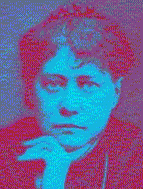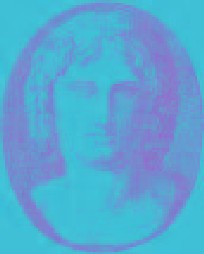THEOSOPHY
AENEID
Cardiff, Wales, UK, CF24 – 1DL.
H
P Blavatsky
Glossary
of the Aeneid
H P Blavatsky cites Virgil’s Aeneid (and other
works)
several
times in The Secret Doctrine, The Theosophical
Glossary and other writings.
C
In
speaking of evolution the following reference is made in The Secret Doctrine,
Volume II page 594:-
Virgil, versed
as every ancient poet was, more or less, in esoteric philosophy, sang evolution
in the following strains:--
Principio coelum ac terras, camposque liquentes
Lucentemque globum lunae, Titaniaque astra
SPIRITUS intus alit; totamque infusa per artus
MENS agitat molem, et
magno se corpore miscet
Inde Hominum pecudumque genus, etc. (Aeneid VI. )
H P B goes
on to give the following translation and elaboration
"First
Divine Spirit within sustains the Heavens, the earth and watery plains, the
moon's orb and shining stars and the Eternal Mind diffused through all the
parts of nature, actuates the whole stupendous frame and mingles with the vast
body of the universe. Thence proceed the race of men
and beasts, the vital principles of the flying kind and the monsters which the
Ocean breeds under its smooth crystal plane."
"All
proceeds from Ether and from its seven natures" -- said the alchemists.
Science knows these only in their superficial effects.
Here is an
alternative translation
‘Firstly, a spirit
within them nourishes the sky and earth,
the watery plains, the shining orb of the
moon,
and Titan’s star, and Mind, flowing through
matter,
vivifies the whole mass, and mingles with its vast
frame.
From it come the
species of man and beast, and winged lives,
and the monsters the sea contains beneath its
marbled waves.
Reference
Aeneid Book VI lines 724 -30
An overview, glossary and complete text of
this epic poem is provided here as a resource.
Publius Vergilius
Maro (Virgil)
Overview
of the Aeneid
Virgil (Publius Vergilius Maro 70 – 19 BCE) was
writing at a time when the Romans were struggling to produce a literature that
was comparable to the Greek. Virgil’s epic, The Aeneid is considered to be the
greatest poem in Latin.
The Aeneid is the story of the founding of
the Roman People. It follows the fortunes of the Trojan hero Aeneas and
followers from their survival of and escape from the fall of
Although
the Aeneid shares many characteristics with the Homeric epic, as an epic it is
different in important ways. For this reason, the Aeneid is referred to as a
literary or secondary epic in order to differentiate it from primitive or primary
epics such as the Homeric poems. The terms “primitive”, “primary” and
“secondary” should not be interpreted as value judgments, but merely as
indications that the original character of the epic was improvisational and
oral, while that of the Aeneid, composed later in the epic tradition, was
basically non-oral and crafted with the aid of writing. As we have seen, the
Homeric poems give evidence of improvisational techniques of composition1
involving the use of various formulas. This style of composition is suited to
the demands of improvisation before an audience which do not allow the poet
time to create new ways of expressing various ideas. In order to keep his
performance going he must depend upon stock phrases, which are designed to fill
out various portions of the dactylic hexameter2 line. On the other hand, Vergil, composing in private, obviously spent much time on
creating his own personal poetic language. Thus in reading the Aeneid you will
notice the absence of the continual repetition of formulas, which are
unnecessary in a literary or secondary epic.
Whether the
Homeric poems were originally improvised without the aid of writing or written
down by the poet himself or dictated to a scribe and then recited, is not known
for certain, but it is clear that they were composed in the style of improvised
oral poetry.
Vergil in the Aeneid uses this traditional meter of
epic poetry.Vergil, however, does imitate Homeric
language without the repetitions. This is another reason for calling the Aeneid
a secondary epic. For example, Vergil occasionally
translates individual Homeric formulas or even creates new formulas in
imitation of Homer such as "pious Aeneas", imitates other Homeric
stylistic devices such as the epic simile and uses the Homeric poems as a
source for story patterns. Although in this sense the Aeneid can be called
derivative, what Vergil has taken from Homer he has
recast in a way which has made his borrowings thoroughly Vergilian
and Roman. For example, Vergil changed the value
system characteristic of the Homeric epic, which celebrated heroic
individualism such as displayed by Achilles in the Iliad.
The heroic
values of an Achilles would have been anachronistic and inappropriate in a poem
written for readers in
Historical Background
Virgil
70-19 (BCE) lived through the politically violent and chaotic years of the
failing Republic, and his writings very clearly show
the influence of the events of this period. Thus, an understanding of the
history of this era is critical to the interpretation of the Aeneid.
In 63 (BCE), a conspiracy to
overthrow the Roman government led by the infamous Catiline
was discovered and defeated through the efforts of Cicero, the consul of that
year. There were, however, other threats to the existing order soon to follow.
After the powerful general Pompey returned from his extensive conquests in the
East in 62, the refusal of the Senate to approve his settlement of affairs
there alienated him from the Optimates.
As a result, he joined in
political alliance with the leaders of the Populares:
Julius Caesar and Marcus Crassus. The alliance has
come to be known as the First Triumvirate and was sealed by the marriage of
Pompey to Caesar’s daughter. Employing the threat of Pompey’s military power,
these three men were able to impose their will on
Caesar
enjoyed great military successes against the Gauls
for almost a ten-year period, but what meant most to him was the fact that he
now had an army loyal to himself, making him equal to Pompey, who had for so
long overshadowed him in military power.
3When Vergil has Anchises predict the civil
war between these two leaders, their names are not mentioned, but they are
referred to as father-in-law and son-in-law (6.828-831).
In
the late 50’s (BCE) with Caesar in
After
his victory Caesar assumed the dictatorship at
Antony
in a set of speeches called the Philippics, which resulted in
After
Following the proscriptions
Cleopatra was a member of the
Ptolemies, the Greek ruling family of Egypt, which
had controlled
After
him
the honorific title of Augustus, which symbolized his special
position
of authority in the state. Octavian was welcomed as a savior by such writers as
Vergil and Horace, the great lyric poet, and by the
vast majority of Romans, because he had brought peace to
The
title “Augustus” had special religious associations and was etymologically
related to the Latin word auctoritas ‘authority’.
Glossary
Achates A companion and friend of Aeneas in his wanderings, and
styled by Vergil fidus Achates, so that his fidelity has become proverbial. Aeneas Son of Aphrodite
(Venus) and Anchises, a mortal Trojan prince, and the hero of Virgil’s Aeneid.
After
Allecto One of the Furies called up from the Underworld in the
Aeneid.
Amata
Queen of Latium and mother of Lavinia,
whom Aeneas married.
Anchises Trojan prince,
father of the hero Aeneas by Aphrodite. After the fall of
Antenor
A Trojan prince related to Priam. He was the husband
of Theano , daughter of Cisseus,
king of Thrace, and father of nineteen sons, of whom the most known were Polybus, Acamas, Agenor, Polydamas, Helicaon, Archilochus, and Laodocus. He is accused by some of having betrayed his
country, not only because he gave a favourable
reception to Diomedes, Odysseus, and MenelaŸs, when they came to Troy, as ambassadors from the
Greeks, to demand the restitution of Helen, but also because he withheld the
fact of his recognizing Odysseus, at the time that hero visited the city under
the guise of a mendicant (Od. iv. 335). After the
conclusion of the war Antenor , according to some, migrated with a party of followers
into
Ascanius In Greek and Roman mythology, Ascanius
was a son of Aeneas and Creusa. After the Trojan War,
Aeneas escaped to
Camilla A
queen of the Volsci, and daughter of Metabus and Casmilla. Her father,
who reigned at Privernum, having by his tyranny
rendered himself odious to his subjects, was by them expelled from his
dominions, and forced to take refuge from their fury in the lonely woods. Here
he bred up the infant Camilla, the sole companion of his flight; and, having
dedicated her to the service of Diana, he instructed her in the use of the bow
and arrow, and accustomed her to the practice of martial and sylvan exercises.
She was so remarkable for her swiftness that she is described by the poets as
flying over the corn without bending the stalks, and skimming over the surface
of the water without wetting her feet. Attended by a train of warriors, she led
the Volscians to battle against Aeneas. Many brave
chiefs fell by her hand; but she was at length herself killed by a soldier of
the name of Aruns, who, from a place of concealment,
aimed a javelin at her. Diana, however, who had foreseen this fatal event, had
commissioned Opis, one of her nymphs, to avenge the
death of Camilla, and Aruns was
slain in his flight from the combat by the arrows of the goddess.
Carthage Powerful colony of Tyre on the north coast of Africa, directly south of
Creusa
Daughter of Priam and Hecuba, and wife of Aeneas.
When
Evander
A figure in Latin mythology. He was said to be the son of
Hermes and an Arcadian nymph (Pausan. viii. 43. 2; Quaest. Rom. 53). Sixty years before the Trojan War he led
a Pelasgian colony to Latium
from Pallantium in Arcadia, and founded a city, Pallantium, near the Tiber, on the hill which was
afterwards named after it the Palatine. Further it was said that he taught the
rude inhabitants of the country writing, music, and other arts; and introduced
from Arcadia the worship of certain gods, in particular of Pan, whom the
Italians called Faunus, with the festival of the Lupercalia, which was held in his honour. Evander was worshipped at Rome among the heroes of the
country, and had an altar on the Aventine Hill. In Vergil, Pallas, the son of Evander,
marches, at the command of his father, to assist Aeneas, and falls in single
combat with Turnus. (See Verg. Aen. viii. 575.) Evander had also two daughters, Romé and Dyna.
Iris A
personification of the rainbow and Hera’s special
messenger, she was married to Zephyrus, the West Wind.
Juturna The nymph of a fountain in Latium,
famous for its healing qualities, whose water was used in many of the
sacrifices. A pond in the Forum, between the temples of Castor and Vesta, was called Lacus Iuturnae.
The nymph is said to have been beloved by Iupiter,
who rewarded her with immortality and dominion over the waters. Vergil calls her the sister of Turnus. Latinus Son of Faunus and of the nymph Marica (or, according to another story, of Heracles and
Fauna, or of Odysseus and Circe). He was king of Latium
and father of Lavinia, the wife of Aeneas. He hosted
Aeneas’ army of exiled Trojans and let them reorganize their life in Latium. His daughter Lavinia had
been promised to Turnus, king of the Rutuli, but Latinus preferred to
offer her to Aeneas. Turnus consequently declared war
on Aeneas (at the urging of Hera). The outcome was that Turnus
was killed and his people captured. Ascanius, the son
of Aeneas, founded Alba Longa and was the first in a
long series of kings.
Lausus
Son of Mezentius, king of the Etruscans, slain by
Aeneas. Lavinia
The daughter of Latinus and Amata, betrothed to Turnus, but
married to Aeneas.
Lethe In
Hades, the
Mercury Roman name for
Hermes, messenger of the Olympian gods. Mezentius A king
of Caere in
Pallas In
the Aeneid, a son of Evander whom Turnus
kills. Punic Wars A series of three wars
between Rome and Carthage that began in 264 B.C. and ended in 146 B.C. with the
total destruction of Carthage, foreshadowed in the Aeneid by Dido’s fatal
affair with Aeneas. Tartarus The dark abyss beneath
Hades’ realm where Zeus chained the fallen Titans and where the wicked suffered
torment. Turnus
King Turnus of the Rutuli
was an ancient king killed by Aeneas. The son of Daunus and Venilia, brother of Iuturna, king of the Rutulians at
Ardea. He was induced by Amata,
the sister of his mother, and wife of Latinus, to
make war upon Aeneas for his bride Lavinia, who had
already been betrothed to himself. He was a close ally of Queen Camilla of the Volsci, who helped him fight Aeneas. After many hard fights
he was slain in single combat by his rival. His name is probably connected with
Tyrrhenus, and in the legends is associated with that
of Mezentius; so that the story is supposed by some
to refer to a struggle of the Latins against the
Etruscans.
Vulcan
Roman name for Hephaestus, god of fire and the forge.
Try these links for
more
info about Theosophy
Cardiff Theosophical Society meetings
are informal
and there’s always a cup of tea afterwards
The Cardiff Theosophical Society Website
The
National Wales Theosophy Website
Theosophy Cardiff’s Instant Guide to Theosophy
Theosophy Cardiff’s Gallery of Great Theosophists
Dave’s Streetwise Theosophy Boards
The Theosophy Website that welcomes
If you run a Theosophy Study Group,
please
feel free to use any
material on this Website
Independent Theosophy Blog
The Most Basic Theosophy
Website in the Universe
A quick overview of Theosophy
and the Theosophical Society
If you run a Theosophy Study Group you
can use this as an introductory handout.
One liners and quick explanations
About aspects of Theosophy
The Voice of the Silence Website
An
Independent Theosophical Republic
Links
to Free Online Theosophy
Study
Resources; Courses, Writings,
The main criteria
for the inclusion of
links on this site is
that they have some
relationship (however
tenuous) to Theosophy
and are lightweight,
amusing or entertaining.
Topics include
Quantum Theory and Socks,
Dick Dastardly and Legendary Blues Singers.
An entertaining introduction to Theosophy
For everyone everywhere, not just in Wales
It’s all “water
under the bridge” but everything you do
makes an imprint on
the Space-Time Continuum.
A selection of
articles on Reincarnation
Provided in
response to the large number
of enquiries we
receive on this subject
No
Aardvarks were harmed in the
The Spiritual Home of Urban Theosophy
The Earth Base for Evolutionary Theosophy
The Birmingham Annie Besant Lodge
_________________________
The Theosophy Cardiff Guide to
The Theosophy Cardiff Guide to
The Theosophy Cardiff Guide to
The Terraced Maze of Glastonbury Tor
Glastonbury and
Joseph of Arimathea
The Grave of King Arthur & Guinevere
Views of Glastonbury High Street
The Theosophy Cardiff Guide to
_____________________
Camberley Surrey England GU15 2LF
Tekels Park to be Sold to a Developer
Concerns are raised about the fate of the wildlife as
The Spiritual Retreat, Tekels Park in Camberley,
Surrey, England is to be sold to a developer
Tekels Park is a 50 acre woodland
park, purchased
for the Adyar
Theosophical Society in England in 1929.
In addition to concern about the
park, many are
worried about the
future of the Tekels Park Deer
as they are not a
protected species.
Confusion as the Theoversity
moves out of
Tekels Park to Southampton, Glastonbury &
Chorley in Lancashire while the leadership claim
that the Theosophical
Society will carry on using
Tekels Park despite its sale to a developer
Anyone planning a “Spiritual” stay at
the
Tekels Park Guest House should be
aware of the sale.
Future
of Tekels Park Badgers in Doubt
Magnificent
Tekels Park to be Sold to a Developer
Tekels Park & the Loch Ness Monster
A Satirical view
of the sale of Tekels Park
in Camberley,
Surrey to a developer
The Toff’s Guide to the Sale of
Tekels Park
What the men in
top hats have to
say about the sale
of Tekels Park
_____________________
A B C D EFG H IJ KL M N OP QR S T UV WXYZ
Complete Theosophical Glossary in Plain Text Format
1.22MB
___________________________
Classic Introductory
Theosophy Text
A Text Book of Theosophy By C
What Theosophy Is From the Absolute to Man
The Formation of a Solar System The Evolution of Life
The Constitution of Man After Death Reincarnation
The Purpose of Life The Planetary Chains
The Result of Theosophical Study
_____________________
Preface to the American Edition Introduction
Occultism and its Adepts The Theosophical Society
First Occult Experiences Teachings of Occult Philosophy
Later Occult Phenomena Appendix
Try these if you are looking for
a
local Theosophy Group or Centre
UK Listing of Theosophical Groups
General pages
about Wales, Welsh History
and The History of
Theosophy in Wales
Wales is a
Principality within the United Kingdom
and has an eastern
border with England.
The land area is
just over 8,000 square miles.
Snowdon in North Wales is
the highest mountain at 3,650 feet.
The coastline is
almost 750 miles long.
The population of Wales as at the 2001 census
is 2,946,200.
_______________________________
Cardiff, Wales, UK, CF24 – 1DL.
_____________________________
Theosophical
Movement in Wales
Mystery Benefactor Boosts Theosophy
in
Bangor, Conwy & Swansea 2009




